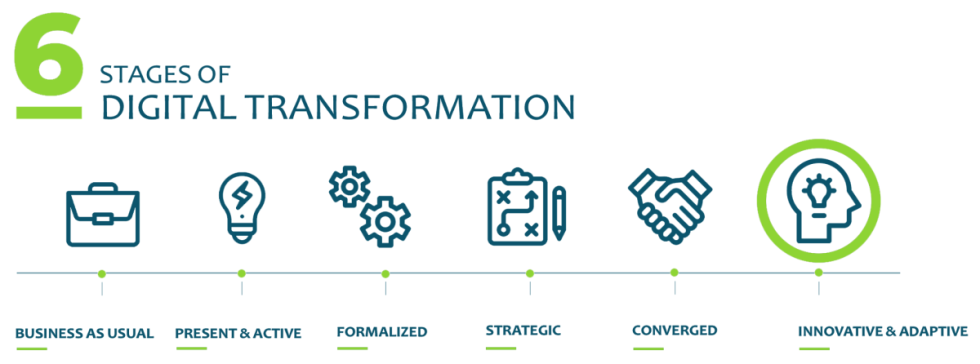Digital transformation has become the fuel for businesses to adapt to today’s ever-changing world. At its core, digital transformation is about integrating digital technology into all areas of a business, fundamentally changing how it operates and delivers value to customers. It’s about evolving with the changing business environment and leveraging technology to improve processes, culture, and customer experiences. Embrace change and seize the opportunities that lie ahead by understanding the journey to a successful digital future.

Digital transformation is not an overnight endeavor. It’s a voyage with distinct steps. Each phase forms a crucial steppingstone on the path to a successful, integrated digital future. These steps represent a distinct set of activities and objectives designed to achieve transformation objectives. They serve as a blueprint for a purposeful and advantageous digital transformation. You can use it to validate, benchmark, and map your organization’s progress toward digital literacy and leadership, which may result in an effective digital transformation strategy and substantial business growth.
The Process of Digital Transformation
Let’s go through the most common stages of digital transformation, to provide a comprehensive understanding of each phase and the value it brings to businesses. From “business as usual” to the advanced stages of convergence and innovation, we explore how your business can navigate this transformative journey, enabling you to harness the full potential of digital technologies.

Business as Usual
In the first stage, a business will operate with a “but this is how we have always done it” legacy perspective of customers, processes, metrics, business models and technology. A “business centric” mentality to marketing and sales, with technology and processes that are usually outdated and ineffective.
This isn’t necessarily a symptom of ignorance that the world is changing or even arrogance to the need for change, but simply being unaware of the risks and opportunities that the connected world now offers them and a fear of change or making an “expensive mistake”.
Present and Active
As companies transition into the second state, we see a growing sense of urgency, more experimentation, and a focus on digital literacy. Experimentation of new technology, social media and mobile becomes more formalized.
The business leadership are still not fully on board and so there is little “joined up” thinking but departments such as marketing and sales are now testing and improving key touchpoints with visitors, leads and customers plus gathering data to build a case for senior leadership buy in and sponsorship.
Formalized
This is the most common stage where digital experimentation becomes directed and intentional, and initiatives become bolder. The changemakers within the company have now built a solid case and trigger executive sponsorship for investment in people, processes, technology and external expertise.
The major change in this stage is the move to buyer centric thinking with the development of “buyer personas” and an inbound approach to marketing. Social media is now being actively used, with digital insights being developed for buyers at each stage of their journey and shared socially, social listening and customer service are also being integrated into the social strategy. The website is mobile optimized, with messenger and chat bots being used to develop conversational strategy.
Strategic
The key characteristic of stage four is the alignment of departments with collaboration, sharing information and research. The Digital Customer Experience (DCX) is now at the heart of everything the business does, cross-platform and cross-department.
The business is leveraging Customer Relationship Management (CRM) software to give marketing, sales, sales-enablement, and service “one customer view”. Insight is used to evolve and mature buyer personas. All digital transformation efforts are intentional with short-term, long-term goals, investment, and full alignment to business KPI’s.
Converged
By the fifth stage, digital transformation is baked into the organization’s DNA from governance, leadership, people, operations, customer experience, data, analytics, technology integration and digital literacy. A digital transformation team has been created to drive continued innovation, strategy and growth based around business and buyer-centric goals.
Digital literacy is now a part of business, learning is continuous and decision making is data driven and optimized for results.
Innovative and Adaptive
Digital transformation is an iterative process – never stopping. The sixth stage is a never-ending phase with a culture of innovation prevalent across the organization. Investment and strategy now switch to innovation, to accelerate transformation and identify new “unconventional” opportunities for growth.
The focus of the Digital Transformation team switches to “disruption” and innovation centers are developed for research and development, plus to recruit new talent into the organization. New technology and acquisition opportunities are identified.
Leadership and executives are meeting regularly with industry and technology influencers, to identify best digital practice from other markets.
Preparing Your Business for Tomorrow
It’s important to understand that there are different points  in the journey when your organization is going through significant change. Acknowledging these stages provides organizations with a clear roadmap and direction. Knowing what to do and how to guide your company through each point on the curve can mean the difference between success and failure for your proposed digital transformation.
in the journey when your organization is going through significant change. Acknowledging these stages provides organizations with a clear roadmap and direction. Knowing what to do and how to guide your company through each point on the curve can mean the difference between success and failure for your proposed digital transformation.
A successful digital transformation journey necessitates balancing technology adoption with strategy, leadership, and culture. It requires learning to walk before running and understanding that skipping stages or trying to leapfrog the process will not yield the desired results. Remember that digital transformation is a continuous process. As newer and more advanced technologies are introduced, you have to work on leveraging them to benefit your business.
Do you need help creating a digital transformation plan for your business? If you’re looking for an experienced partner to guide you, connect with the experts at PointSolve. We help businesses in their digital transformation journey by delivering solutions that work hand-in-hand to help you achieve more efficient processes: cybersecurity, cloud services, strategic IT planning, and more!

